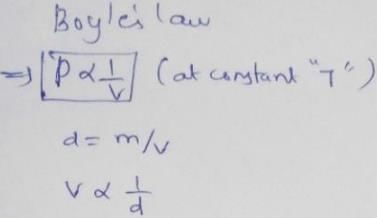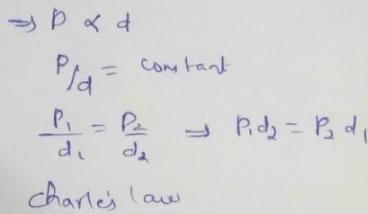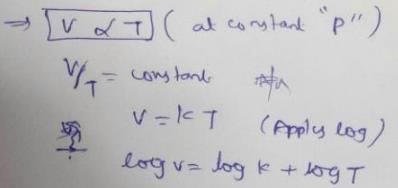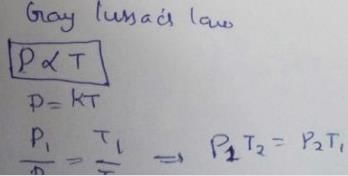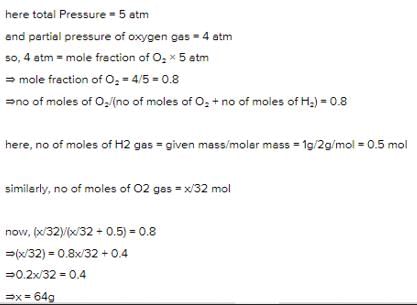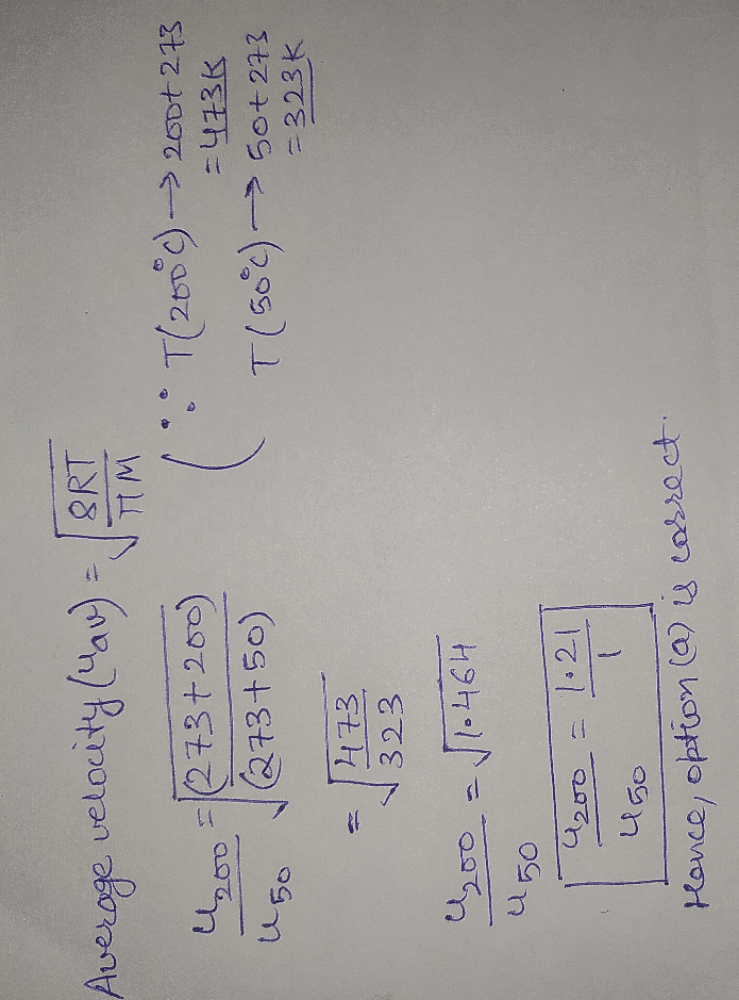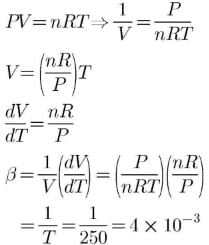All Exams >
JEE >
6 Months Preparation for JEE >
All Questions
All questions of Gaseous State for JEE Exam
Graph for Boyle's law is called- a)isotherm
- b)hypertherm
- c)hypotherm
- d)none
Correct answer is option 'A'. Can you explain this answer?
Graph for Boyle's law is called
a)
isotherm
b)
hypertherm
c)
hypotherm
d)
none
|
|
Rohan Singh answered |
Boyle's law: Graph between P and V at constant temperature is called isotherm and is an equilateral (or rectangular) hyperbola. By plotting P versus 1/V, this hyperbola can be converted to a straight line.
For Charles’ law, graphical representation between log V and log T under isobaric condition is shown below for equation V = kT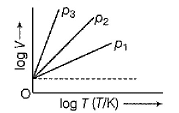 Q. Volume V = constant k, when
Q. Volume V = constant k, when- a)T = 0oc
- b)T = 273oc
- c)T = 0K
- d)T = -272oc
Correct answer is option 'D'. Can you explain this answer?
For Charles’ law, graphical representation between log V and log T under isobaric condition is shown below for equation V = kT
Q. Volume V = constant k, when
a)
T = 0oc
b)
T = 273oc
c)
T = 0K
d)
T = -272oc

|
Ciel Knowledge answered |
-272deg.
For C = 1 K
V / 1 = K
V = K
For C = 1 K
V / 1 = K
V = K
Use of hot air balloons is an application of:- a)Gay Lussac’s law
- b)Avogadro’s law
- c)Charles’ law
- d)Boyle’s law
Correct answer is option 'C'. Can you explain this answer?
Use of hot air balloons is an application of:
a)
Gay Lussac’s law
b)
Avogadro’s law
c)
Charles’ law
d)
Boyle’s law
|
|
Riya Banerjee answered |
The relationship between the temperature and volume of a gas, which is known as Charles' law, provides an explanation of how hot-air balloons work.
Consider the reaction, 2X(g) + 3Y(g) → Z(g)Where gases X and Y are insoluble and inert to water and Z form a basic solution. In an experiment 3 mole each of X and Y are allowed to react in 15 lit flask at 500 K. When the reaction is complete, 5L of water is added to the flask and temperature is reduced to 300 K. The pressure in the flask is (neglect aqueous tension)- a)1.64 atm
- b)2.46 atm
- c) 4.92 atm
- d) 3.28 atm
Correct answer is option 'B'. Can you explain this answer?
Consider the reaction, 2X(g) + 3Y(g) → Z(g)
Where gases X and Y are insoluble and inert to water and Z form a basic solution. In an experiment 3 mole each of X and Y are allowed to react in 15 lit flask at 500 K. When the reaction is complete, 5L of water is added to the flask and temperature is reduced to 300 K. The pressure in the flask is (neglect aqueous tension)
a)
1.64 atm
b)
2.46 atm
c)
4.92 atm
d)
3.28 atm
|
|
Mira Joshi answered |
The reaction is
2X(g) + 3Y(g) → Z(g)
2 moles of X reacts with 3 moles of Y to form 1mole of Z.
Now 3 moles of X and 3 moles of Y are present in the flask. Y is the limiting reagent. (Tocheck LR, divide the no of moles by stoichiometric coff. of that element. The least value will be LR)
After reaction, 1 mole of X is remaining and 1 mole of Z is formed, X is insoluble in water whereas Z is soluble in water.
Thus, the pressure in the flask is due to 1 mole of X.
The total volume of the flask is 15 L. The volume of water is 5 L. Thus the volume of gas is 15-5 = 10L.
The ideal gas equation is pV = nRT
Hence ,
p = nRT/V = 1×0.0821×300/10
= 2.46 atm
2X(g) + 3Y(g) → Z(g)
2 moles of X reacts with 3 moles of Y to form 1mole of Z.
Now 3 moles of X and 3 moles of Y are present in the flask. Y is the limiting reagent. (Tocheck LR, divide the no of moles by stoichiometric coff. of that element. The least value will be LR)
After reaction, 1 mole of X is remaining and 1 mole of Z is formed, X is insoluble in water whereas Z is soluble in water.
Thus, the pressure in the flask is due to 1 mole of X.
The total volume of the flask is 15 L. The volume of water is 5 L. Thus the volume of gas is 15-5 = 10L.
The ideal gas equation is pV = nRT
Hence ,
p = nRT/V = 1×0.0821×300/10
= 2.46 atm
Compressibility factor for CO2 at 400 K and 71.0 bar is 0.8697. Molar volume of CO2 under these conditions is- a)22.4 L
- b)2.24 L
- c)0.41 L
- d)19.5 L
Correct answer is option 'C'. Can you explain this answer?
Compressibility factor for CO2 at 400 K and 71.0 bar is 0.8697. Molar volume of CO2 under these conditions is
a)
22.4 L
b)
2.24 L
c)
0.41 L
d)
19.5 L

|
Lohit Matani answered |
We know that
Z = pVobserved /RT
0.8697 = 71×0.987×Vobserved / 0.0821×400
Vobserved = 0.8697×0.0821×400/71×0.987
= 0.406 L or 0.41 L
Z = pVobserved /RT
0.8697 = 71×0.987×Vobserved / 0.0821×400
Vobserved = 0.8697×0.0821×400/71×0.987
= 0.406 L or 0.41 L
The slope of plot between pV and p at constant temperature is:- a)1
- b)2
- c)1/2
- d)Zero
Correct answer is 'D'. Can you explain this answer?
The slope of plot between pV and p at constant temperature is:
a)
1
b)
2
c)
1/2
d)
Zero
|
|
Shreya Gupta answered |
Slope of the plot between P and PV at constant temperature is zero. A plot of P v/s PV at constant temperature for a fixed mass of gas is a straight line parallel to the pressure axis.

The vapour pressure of water at 300 K in a closed container is 0.4 atm. If the volume of the container is doubled, its vapour pressure at 300 K will be- a)0.8 atm
- b)0.2 atm
- c)0.4 atm
- d)0.6 atm
Correct answer is option 'C'. Can you explain this answer?
The vapour pressure of water at 300 K in a closed container is 0.4 atm. If the volume of the container is doubled, its vapour pressure at 300 K will be
a)
0.8 atm
b)
0.2 atm
c)
0.4 atm
d)
0.6 atm
|
|
Rohan Singh answered |
The vapour pressure of water will remain same as the temperature is unchanged. So, the answer is c) 0.4 atm
A capillary tube of uniform diameter contains gas samples A and B, separated by a short column of Hg, L mm in length. The ends are sealed. In horizontal position, the confined gases occupy 'a' mm and 'b' mm in length with a common unknown pressure (P). In vertical position, the lengths become respectively a' mm and b' mm. Then P is equal to- a)

- b)

- c)

- d)

Correct answer is option 'A'. Can you explain this answer?
A capillary tube of uniform diameter contains gas samples A and B, separated by a short column of Hg, L mm in length. The ends are sealed. In horizontal position, the confined gases occupy 'a' mm and 'b' mm in length with a common unknown pressure (P). In vertical position, the lengths become respectively a' mm and b' mm. Then P is equal to
a)
b)
c)
d)
|
|
Krishna Iyer answered |
By ideal gas law: PV=nRT
For a particular gas since n and T are constant. ⇒PV=Constant
⇒ For gas A
Pa=PAa′..............(i) (Here length (a) is directly proportional to volume. Hence it can be used in place of volume.)
⇒ For gas B
Pb=PBb′.......(ii)
Since gas B is supporting l length of mercury over it in addition to gas A
⇒PB=PA+ρgl..........(iii) ( ρ is the density of mercury)
Putting (iii) in (ii)
⇒Pb=(PA+ρgl)b′............(iv)
Eliminating PA
from (i) and (iv)
⇒Pb=Pa/a′b′+ρglb′⇒Pba′−ab′)/a’=ρglb′
⇒P=ρgla′b′/ba’-ab’(in SI units)
⇒P in mm of Hg =dP(in SI)/ρg
P(mmHg)=la′b′/ba′-ab′ = l/(b/b′) - (a/a′)
Thus (a) is the correct option
For a particular gas since n and T are constant. ⇒PV=Constant
⇒ For gas A
Pa=PAa′..............(i) (Here length (a) is directly proportional to volume. Hence it can be used in place of volume.)
⇒ For gas B
Pb=PBb′.......(ii)
Since gas B is supporting l length of mercury over it in addition to gas A
⇒PB=PA+ρgl..........(iii) ( ρ is the density of mercury)
Putting (iii) in (ii)
⇒Pb=(PA+ρgl)b′............(iv)
Eliminating PA
from (i) and (iv)
⇒Pb=Pa/a′b′+ρglb′⇒Pba′−ab′)/a’=ρglb′
⇒P=ρgla′b′/ba’-ab’(in SI units)
⇒P in mm of Hg =dP(in SI)/ρg
P(mmHg)=la′b′/ba′-ab′ = l/(b/b′) - (a/a′)
Thus (a) is the correct option
Direction (Q. Nos. 16-19) This section contains a paragraph, wach describing theory, experiments, data etc. three Questions related to paragraph have been given.Each question have only one correct answer among the four given options (a),(b),(c),(d).Passage IVolume occupied by molecules is negligible compared to total volume of molecules. We have N2 gas molecules assuming them spherical of radius 200 pm. Q. Total volume of molecules contained in one mole of the gas is- a)22400 cm3
- b)3.721 x 10-22 cm3
- c)4 .65 x 10-23 cm3
- d)20.1 8cm3
Correct answer is option 'D'. Can you explain this answer?
Direction (Q. Nos. 16-19) This section contains a paragraph, wach describing theory, experiments, data etc. three Questions related to paragraph have been given.Each question have only one correct answer among the four given options (a),(b),(c),(d).
Passage I
Volume occupied by molecules is negligible compared to total volume of molecules. We have N2 gas molecules assuming them spherical of radius 200 pm.
Q. Total volume of molecules contained in one mole of the gas is
a)
22400 cm3
b)
3.721 x 10-22 cm3
c)
4 .65 x 10-23 cm3
d)
20.1 8cm3
|
|
Riya Banerjee answered |
Volume of single molecule = 4/3π(r)3
= 4/3×π×(200×10-12)3 m3
V = 3.349×10-29 m3
Volume of 1 mole (NA molecules) = 3.349×10-29 m3×6.022×1023
= 2.016×10-5 m3
= 2.016×10-5×106 cm3 or 20.16 cm3
= 4/3×π×(200×10-12)3 m3
V = 3.349×10-29 m3
Volume of 1 mole (NA molecules) = 3.349×10-29 m3×6.022×1023
= 2.016×10-5 m3
= 2.016×10-5×106 cm3 or 20.16 cm3
Volume of an ideal gas is to be decreased by 10% by increase of pressure by x% under isothermal condition. Thus, x is- a)100/9
- b)9/100
- c)10
- d)1/10
Correct answer is option 'A'. Can you explain this answer?
Volume of an ideal gas is to be decreased by 10% by increase of pressure by x% under isothermal condition. Thus, x is
a)
100/9
b)
9/100
c)
10
d)
1/10
|
|
Neha Sharma answered |
Applying Boyle 's law P1V1=P2V2 as temp is constant.
So let initial pressure =P initial volume =V
Now final volume V2=V-10%of V =9V/10
PV=P2×9V/10 so P2=10P/9
Therefore increment in Pressure=P/9P×100%=100/9
So let initial pressure =P initial volume =V
Now final volume V2=V-10%of V =9V/10
PV=P2×9V/10 so P2=10P/9
Therefore increment in Pressure=P/9P×100%=100/9
Mass of gas is 300 gm and its specific heat at constant volume is 750J/kg K. if gas is heated through 75°C at constant pressure of 105 N/m2, it expands by volume 0.08 × 106 cm3. find CP/CV.- a)1.4
- b) 1.374
- c) 1.474
- d)1.5
Correct answer is option 'D'. Can you explain this answer?
Mass of gas is 300 gm and its specific heat at constant volume is 750J/kg K. if gas is heated through 75°C at constant pressure of 105 N/m2, it expands by volume 0.08 × 106 cm3. find CP/CV.
a)
1.4
b)
1.374
c)
1.474
d)
1.5
|
|
Krishna Iyer answered |
Data given;
ΔT = 75 oC = 75 K
ΔV = 0.08 * 106 cm3 = 0.08 m3
Cv = 750 J kg-1 K-1
m = 300 g = 0.300 kg
p = 105 N m-2 = 100000 N m-2
The first law of thermodynamics;
ΔU = Q – W
Q = ΔU + W ---- (1)
mCpΔT = mCvΔT + pΔV ----- (2)
Dividing the above expression (2) with Cv , we get;
Cp / Cv = Cv / Cv + pΔV / mΔTCv
Cp / Cv = 1 + pΔV / mΔTCv
Cp / Cv = 1 + ([100000 N m-2 . 0.08 m3] / [0.300 kg . 75 K .750 J kg-1K-1])
Cp / Cv = 1 + 0.474
Cp / Cv = 1.474 ; After rounding it off we get,
= 1.5 (appx)
ΔT = 75 oC = 75 K
ΔV = 0.08 * 106 cm3 = 0.08 m3
Cv = 750 J kg-1 K-1
m = 300 g = 0.300 kg
p = 105 N m-2 = 100000 N m-2
The first law of thermodynamics;
ΔU = Q – W
Q = ΔU + W ---- (1)
mCpΔT = mCvΔT + pΔV ----- (2)
Dividing the above expression (2) with Cv , we get;
Cp / Cv = Cv / Cv + pΔV / mΔTCv
Cp / Cv = 1 + pΔV / mΔTCv
Cp / Cv = 1 + ([100000 N m-2 . 0.08 m3] / [0.300 kg . 75 K .750 J kg-1K-1])
Cp / Cv = 1 + 0.474
Cp / Cv = 1.474 ; After rounding it off we get,
= 1.5 (appx)
At constant temperature, the pressure of a fixed amount of gas varies inversely with its volume, is- a)Boyle’s law
- b)Gay Lussac’s law
- c)Avogadro law
- d)Charles’ law
Correct answer is option 'A'. Can you explain this answer?
At constant temperature, the pressure of a fixed amount of gas varies inversely with its volume, is
a)
Boyle’s law
b)
Gay Lussac’s law
c)
Avogadro law
d)
Charles’ law
|
|
Shreya Gupta answered |
Boyle’s law states that the volume of a fixed mass of a gas is inversely proportional to its pressure at constant temperature.
A 8.3 L cylinder contains 128 . 0 g O2 gas at 27°C. What mass of O2 gas must be released to reduce the pressure to 6.0 bar ?- a)64.0 g
- b)32.0 g
- c)16.0 g
- d)8.0 g
Correct answer is option 'A'. Can you explain this answer?
A 8.3 L cylinder contains 128 . 0 g O2 gas at 27°C. What mass of O2 gas must be released to reduce the pressure to 6.0 bar ?
a)
64.0 g
b)
32.0 g
c)
16.0 g
d)
8.0 g
|
|
Rajesh Gupta answered |
By applying ideal gas eqn. PV = nRT
Further solving it we get an eq.
w = PVM/RT
Putting values, we get 64g.
Hence, the correct answer is Option A.
Further solving it we get an eq.
w = PVM/RT
Putting values, we get 64g.
Hence, the correct answer is Option A.
The value of universal gas constant R depends on:- a)Number of moles of gas
- b)Units of volume and pressure
- c)Volume of gas
- d)Temperature of gas
Correct answer is option 'B'. Can you explain this answer?
The value of universal gas constant R depends on:
a)
Number of moles of gas
b)
Units of volume and pressure
c)
Volume of gas
d)
Temperature of gas
|
|
Pooja Mehta answered |
We have
R = PV/T
= 8.314JK^−1mol^−1
= 8.314x10^7ergK^−1mol^−1
= 2calK^−1mol^−1
= 0.0821litreatmK^−1mol^−1
Hence R depends on units of volume and pressure
Hence answer is (b)
At constant volume, pressure of a fixed amount of a gas varies directly with the temperature, is- a)Gay Lussac’s law
- b)Avogadro law
- c)Boyle’s law
- d)Charles’ law
Correct answer is option 'A'. Can you explain this answer?
At constant volume, pressure of a fixed amount of a gas varies directly with the temperature, is
a)
Gay Lussac’s law
b)
Avogadro law
c)
Boyle’s law
d)
Charles’ law
|
|
Anjali Iyer answered |
Gay Lussac’s law states that the pressure of a fixed mass of a gas at constant volume is directly proportional to the temperature on Kelvin scale.
Root mean square velocity (u) is dependent on temperature. Value of  is
is- a)

- b)

- c)

- d)

Correct answer is option 'B'. Can you explain this answer?
Root mean square velocity (u) is dependent on temperature. Value of  is
is
a)
b)
c)
d)
|
|
Krishna Iyer answered |
The correct answer is option B
Root mean square is v=under root 3RT/M
so we simply do differentiation with respect to temperature DU/DT=D /DT
/DT
So,
= 3R/2M
Root mean square is v=under root 3RT/M
so we simply do differentiation with respect to temperature DU/DT=D
 /DT
/DT So,
= 3R/2M
Bond energy of H2 gas is 104 kcal mol-1. The temperature at which average kinetic energy of gaseous H2 molecules is equal to energy required to dissociate the molecules into atoms, is- a)34620 K
- b)34893 K
- c)31200 K
- d)32723 K
Correct answer is option 'B'. Can you explain this answer?
Bond energy of H2 gas is 104 kcal mol-1. The temperature at which average kinetic energy of gaseous H2 molecules is equal to energy required to dissociate the molecules into atoms, is
a)
34620 K
b)
34893 K
c)
31200 K
d)
32723 K
|
|
Preeti Khanna answered |
Bond energy is the energy to break bonds and convert the sample into atoms.
We know that,
K.E of a mol of gas molecule = 3/2 RT
A/Q 3/2 RT = 104 kcal mol-1
3/2×8.314×T = 104×103 x 4.18 J
T = 34893 K
We know that,
K.E of a mol of gas molecule = 3/2 RT
A/Q 3/2 RT = 104 kcal mol-1
3/2×8.314×T = 104×103 x 4.18 J
T = 34893 K
Density of an ideal gas at 298 K and 1.0 atm is found to be 1.25 kg m-3. Density of the gas at 1.5 atm and at 298 K is - a)1.25 kg m-3
- b)1.875 kg m-3
- c)1.00 kg m-3
- d)1.20 kg m-3
Correct answer is option 'B'. Can you explain this answer?
Density of an ideal gas at 298 K and 1.0 atm is found to be 1.25 kg m-3. Density of the gas at 1.5 atm and at 298 K is
a)
1.25 kg m-3
b)
1.875 kg m-3
c)
1.00 kg m-3
d)
1.20 kg m-3
|
|
Lavanya Menon answered |
We know ideal gas equation,
PV=nRT.
n= m(mass)/M(molecular weight).
PV=m/M RT.
PM=m/v RT.
density (d)=m(mass)/v (volume).
PM=dRT.
d=PM/RT.
here, density is directly proportional to pressure and inversely proportional to temperature...
d1/d2=P1 T2 / P2 T1.
1.25/d2= 1×298/1.5×298.
1.25/d2=1/1.5.
d2= 1.25×1.5.
d2=1.875
PV=nRT.
n= m(mass)/M(molecular weight).
PV=m/M RT.
PM=m/v RT.
density (d)=m(mass)/v (volume).
PM=dRT.
d=PM/RT.
here, density is directly proportional to pressure and inversely proportional to temperature...
d1/d2=P1 T2 / P2 T1.
1.25/d2= 1×298/1.5×298.
1.25/d2=1/1.5.
d2= 1.25×1.5.
d2=1.875
The temperature in Celsius scale can be converted into Kelvin scale- a)By dividing it with 273
- b)By subtracting 273.15 from it
- c)By multiplying it with 273
- d)By adding 273.15 to it
Correct answer is option 'D'. Can you explain this answer?
The temperature in Celsius scale can be converted into Kelvin scale
a)
By dividing it with 273
b)
By subtracting 273.15 from it
c)
By multiplying it with 273
d)
By adding 273.15 to it
|
|
Krishna Iyer answered |
To convert from Celsius to Kelvin you use the following formula:
Celsius temperature + 273.15 = Kelvin Temperature
For example:
26 °Celsius + 273.15 = 299.15 Kelvin
26 °Celsius + 273.15 = 299.15 Kelvin
The Kelvin temperature scale was designed so that it starts at absolute zero. In Kelvin, absolute zero is equal to 0 degrees. In Celsius, absolute zero is equal to −273.15 degrees.
Therefore, you need to add 273.15 to the Celsius temperature to get to the Kelvin temperature.
Note: Kelvin does not use the degree symbol, °.
A certain gas effuses out of two different vessels A and B. A has a circular orifice while B has a square orifice of length equal to the radius of the orifice of vessel A. The ratio of rate of diffusion of the gas from vessel A to that from vessel B is - a)π : 1
- b)1 : π
- c)1 : 1
- d)3 : 2
Correct answer is option 'A'. Can you explain this answer?
A certain gas effuses out of two different vessels A and B. A has a circular orifice while B has a square orifice of length equal to the radius of the orifice of vessel A. The ratio of rate of diffusion of the gas from vessel A to that from vessel B is
a)
π : 1
b)
1 : π
c)
1 : 1
d)
3 : 2
|
|
Lavanya Menon answered |
More the area more the effusion.
∴r1/r2 = A1/A2
r1/r2 = πr2/r2 = π
∴r1/r2 = A1/A2
r1/r2 = πr2/r2 = π
A cylinder of V litre capacity contains ammonia gas. This cylinder is inverted over another vessel of V litre capacity containing hydrogen chloride at the same temperature and pressure. The pressure in the cylinder after sometime will- a)Remain same
- b)Become 3/2 of the original pressure
- c)Double
- d)Drop
Correct answer is option 'D'. Can you explain this answer?
A cylinder of V litre capacity contains ammonia gas. This cylinder is inverted over another vessel of V litre capacity containing hydrogen chloride at the same temperature and pressure. The pressure in the cylinder after sometime will
a)
Remain same
b)
Become 3/2 of the original pressure
c)
Double
d)
Drop
|
|
Geetika Shah answered |
As per Gay Lussac’s Law, when pressure and temperature are same V directly proportional to the moles. Let n moles of NH3 and n moles HCl after some time they react and form n moles NH4Cl and hence pressure drops.
The standard boiling point of the liquid is
- a)The boiling point at 2 atm pressure.
- b)The boiling point at 1 bar pressure.
- c)The temperature at which a liquid converts to gas.
- d)The boiling point at 1 atm pressure.
Correct answer is option 'B'. Can you explain this answer?
The standard boiling point of the liquid is
a)
The boiling point at 2 atm pressure.
b)
The boiling point at 1 bar pressure.
c)
The temperature at which a liquid converts to gas.
d)
The boiling point at 1 atm pressure.
|
|
Anjana Sharma answered |
The answer is b.
The normal boiling point of liquid is 99.97 degreeC (211.9 degreeF) at a pressure of 1 atm (i.e., 101.325 kPa).
At 298 K, which of the following gases has the lowest average molecular speed?- a)CO2 at 0.20 atm
- b)He at 0.40 atm
- c)CH4 at 0.80 atm
- d)NO at 1.00 atm
Correct answer is option 'A'. Can you explain this answer?
At 298 K, which of the following gases has the lowest average molecular speed?
a)
CO2 at 0.20 atm
b)
He at 0.40 atm
c)
CH4 at 0.80 atm
d)
NO at 1.00 atm
|
|
Preeti Iyer answered |
Under the same conditions the average kinetic energy of the gases should be equal.
speed of gas1/speed of gas 2 = square root of (molar mass of gas2/molar mass of gas 1)
So gases with small molar mass will move quicker
eg speed of N2/speed of CO2 = sq. rt (44/28) = 1.25
speed of N2/speed of F2 = sq rt. (38/28) = 1.16
So order is N2, F2 and CO2
then we concluded right ans. is (A)
speed of gas1/speed of gas 2 = square root of (molar mass of gas2/molar mass of gas 1)
So gases with small molar mass will move quicker
eg speed of N2/speed of CO2 = sq. rt (44/28) = 1.25
speed of N2/speed of F2 = sq rt. (38/28) = 1.16
So order is N2, F2 and CO2
then we concluded right ans. is (A)
Mathematical expression that describes Boyle's law is- a)PV = constant
- b)V * constant = P
- c)P * constant = V
- d)V ⁄ P = constant
Correct answer is option 'A'. Can you explain this answer?
Mathematical expression that describes Boyle's law is
a)
PV = constant
b)
V * constant = P
c)
P * constant = V
d)
V ⁄ P = constant

|
Sreeharsha Hareesh answered |
BOYLE'S LAW
At a constant temperature,volume of a definite mass of gas is inversely proportional to its pressure. hence, if P is the pressure and V is the volume, then P x V is a constant.
he number of elements that exists in gaseous state under normal atmospheric conditions is- a)15
- b)10
- c)5
- d)11
Correct answer is option 'D'. Can you explain this answer?
he number of elements that exists in gaseous state under normal atmospheric conditions is
a)
15
b)
10
c)
5
d)
11
|
|
Hansa Sharma answered |
A look at the periodic table shows us that there are 11 elements in the table that exist in the gaseous state at room temperature. These elements are Hydrogen, Helium, Nitrogen, Oxygen, Fluorine, Chlorine, Neon, Argon, Krypton, Xenon, and Radon.
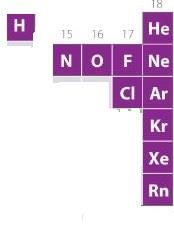
A 10.0 cm column of air is trapped by a column of Hg 4.00 cm long in a capillary tube of uniform bore when the tube is held horizontally at 1 atm. Length of the air column when the tube is held vertically with the open end up is
- a)9.50 cm
- b)10.52 cm
- c)3.53cm
- d)4.61 cm
Correct answer is option 'A'. Can you explain this answer?
A 10.0 cm column of air is trapped by a column of Hg 4.00 cm long in a capillary tube of uniform bore when the tube is held horizontally at 1 atm. Length of the air column when the tube is held vertically with the open end up is
a)
9.50 cm
b)
10.52 cm
c)
3.53cm
d)
4.61 cm

|
Lohit Matani answered |
V1 = 10xcm³
V2 = ?
P1 = 1atm = 760mmHg
P2 = (760 + 4)mmHg
P1V1 = P2V2
V2 = P1V1 / P2
= 760 × 10x / 764
= 9.5x
Therefore,
= 9.5x / x = 9.5
V2 = ?
P1 = 1atm = 760mmHg
P2 = (760 + 4)mmHg
P1V1 = P2V2
V2 = P1V1 / P2
= 760 × 10x / 764
= 9.5x
Therefore,
= 9.5x / x = 9.5
At what temperature (in °C) root mean square velocity of O2 gas at 300 K is equal to most probable velocity of Ne(20 g mol-1)?
Correct answer is '8'. Can you explain this answer?
At what temperature (in °C) root mean square velocity of O2 gas at 300 K is equal to most probable velocity of Ne(20 g mol-1)?
|
|
Preeti Khanna answered |
Vrms = √(3RT/M)
Vmp 0= √(2RT/M)
Putting corresponding values,
3×300/32 = 2×T/20
On solving, we get T = 281.5K
T in °C = 281.5-273 = 8.1 °C = 8
Vmp 0= √(2RT/M)
Putting corresponding values,
3×300/32 = 2×T/20
On solving, we get T = 281.5K
T in °C = 281.5-273 = 8.1 °C = 8
Charle's law defines value of 'k' as- a)V/n
- b)V/V
- c)V/P
- d)V/T
Correct answer is option 'D'. Can you explain this answer?
Charle's law defines value of 'k' as
a)
V/n
b)
V/V
c)
V/P
d)
V/T
|
|
Krishna Iyer answered |
According to Charles law,at constant pressure, V∝T
Or V/T = k
Or V/T = k
Statement I : In van der Waals’ equation, pressure correction is due to force of attraction between molecules.Statement II : Rate of change of momentum is equal to force.- a)Both Statement I and Statement II are correct and Statement II is the correct explanation of Statement I
- b)Both Statement I and Statement II are correct and Statement II is not the correct explanation of Statement i
- c)Statement I is correct but Statement II is incorrect
- d)Statement II is correct but Statement I is incorrect
Correct answer is option 'B'. Can you explain this answer?
Statement I : In van der Waals’ equation, pressure correction is due to force of attraction between molecules.
Statement II : Rate of change of momentum is equal to force.
a)
Both Statement I and Statement II are correct and Statement II is the correct explanation of Statement I
b)
Both Statement I and Statement II are correct and Statement II is not the correct explanation of Statement i
c)
Statement I is correct but Statement II is incorrect
d)
Statement II is correct but Statement I is incorrect

|
Pioneer Academy answered |
Vander waals constant 'a' is a measure of attractive force
The van der waals constant 'a' represents the magnitude of the attractive forces present between gas molecules. Higher is the value of 'a', more easily the gas can be liquefied.
However it has no relation with statement II. Statement II is a general statement.
The van der waals constant 'a' represents the magnitude of the attractive forces present between gas molecules. Higher is the value of 'a', more easily the gas can be liquefied.
However it has no relation with statement II. Statement II is a general statement.
Temperature at which average translation energy of a molecule is equal to the kinetic energy of the electron in first Bohr is orbit is- a)2.02 x 105 K
- b)1.05 x 105 K
- c)273 K
- d)298 K
Correct answer is option 'B'. Can you explain this answer?
Temperature at which average translation energy of a molecule is equal to the kinetic energy of the electron in first Bohr is orbit is
a)
2.02 x 105 K
b)
1.05 x 105 K
c)
273 K
d)
298 K
|
|
Raghav Bansal answered |
Av. Translational Energy of a molecule= 3/2 KT -------(1)
Kinetic Energy of the electron in first Bohr's orbit= 13.6eV = 13.6×1.6×10-19J--------(2)
from eqn. 1&2
3/2KT=13.6×1.6×10-19
T = 1.05×105 K
Kinetic Energy of the electron in first Bohr's orbit= 13.6eV = 13.6×1.6×10-19J--------(2)
from eqn. 1&2
3/2KT=13.6×1.6×10-19
T = 1.05×105 K
At what temperature will the hydrogen molecules have the same kinetic energy per mole as nitrogen molecules at 280 K?- a)280 K
- b)40 K
- c)400 K
- d)50 K
Correct answer is option 'A'. Can you explain this answer?
At what temperature will the hydrogen molecules have the same kinetic energy per mole as nitrogen molecules at 280 K?
a)
280 K
b)
40 K
c)
400 K
d)
50 K
|
|
Ankita Menon answered |
Explanation:
- We know that the kinetic energy of a gas molecule is given by the formula:
K.E. = (3/2) kT
- Here, k is the Boltzmann constant, T is the temperature in Kelvin and (3/2) is the degree of freedom of a gas molecule.
- For diatomic molecules like hydrogen and nitrogen, the degree of freedom is 5 (3 translational and 2 rotational).
- Now, we need to find the temperature at which hydrogen molecules have the same kinetic energy per mole as nitrogen molecules at 280 K.
- Let us assume that the kinetic energy per mole of nitrogen molecules at 280 K is K.
K = (3/2) kTN
- Similarly, the kinetic energy per mole of hydrogen molecules at the same temperature is:
(3/2) kTH
- Now, we need to find the temperature at which both these kinetic energies are equal:
(3/2) kTN = (3/2) kTH
TH = TN
- So, the temperature at which hydrogen molecules have the same kinetic energy per mole as nitrogen molecules at 280 K is 280 K.
Therefore, option A is the correct answer.
Direction (Q. Nos. 5-9) This section contains 5 multiple choice questions. Each question has four choices (a), (b), (c) and (d), out of which ONE or MORE THANT ONE is correct.Q. An ideal gas is at 300 K and 1 atm. Then volume remains constant if- a)temperature is doubled and pressure is halved
- b)temperature is halved and pressure is halved
- c)temperature is doubled and pressure is doubled
- d)only temperature is doubled
Correct answer is option 'C'. Can you explain this answer?
Direction (Q. Nos. 5-9) This section contains 5 multiple choice questions. Each question has four choices (a), (b), (c) and (d), out of which ONE or MORE THANT ONE is correct.
Q. An ideal gas is at 300 K and 1 atm. Then volume remains constant if
a)
temperature is doubled and pressure is halved
b)
temperature is halved and pressure is halved
c)
temperature is doubled and pressure is doubled
d)
only temperature is doubled
|
|
Om Desai answered |
We know that
pV = nRT
Or V = nRT/p
If we increase both T and P 2 times, only then the volume remains constant.
pV = nRT
Or V = nRT/p
If we increase both T and P 2 times, only then the volume remains constant.
Direction (Q. Nos. 1-11) This section contains 11 multiple choice questions. Each question has four choices (a), (b), (c) and (d), out of which ONLY ONE option is correct.Q. Helium atom is two times heavier than a hydrogen molecule (H2). At 298 K, the average kinetic energy of helium atom is- a)two times that of a hydrogen molecule
- b)same as that of a hydrogen molecule
- c)four times that of a hydrogen molecule
- d)half that of a hydrogen molecule
Correct answer is option 'B'. Can you explain this answer?
Direction (Q. Nos. 1-11) This section contains 11 multiple choice questions. Each question has four choices (a), (b), (c) and (d), out of which ONLY ONE option is correct.
Q. Helium atom is two times heavier than a hydrogen molecule (H2). At 298 K, the average kinetic energy of helium atom is
a)
two times that of a hydrogen molecule
b)
same as that of a hydrogen molecule
c)
four times that of a hydrogen molecule
d)
half that of a hydrogen molecule
|
|
Preeti Iyer answered |
Kinetic energy of gas molecule depends on temperature and does not depend upon the nature of gas.
K.E =(3/2)kT.
Thus hydrogen and helium have same K.E at same temperature.
Select the correct statement (s).
- a)Kinetic energy is zero at 0°C
- b)Root mean square velocity of CO2 gas at 298

- c)Distribution of molecules is very small when u → 0 or u → ∞
- d)Most probable velocity has maximum value out of all the molecular velocities
Correct answer is option 'B,C'. Can you explain this answer?
Select the correct statement (s).
a)
Kinetic energy is zero at 0°C
b)
Root mean square velocity of CO2 gas at 298 
c)
Distribution of molecules is very small when u → 0 or u → ∞
d)
Most probable velocity has maximum value out of all the molecular velocities

|
Sanika Shaikh answered |
B is also correct
The compressibility of a gas is less than unity for a gas at STP. Therefore,[IIT JEE 2000]- a)Vm > 22.4 L
- b)Vm < 22.4 L
- c)Vm = 22.4 L
- d)Vm = 44.8 L
Correct answer is option 'B'. Can you explain this answer?
The compressibility of a gas is less than unity for a gas at STP. Therefore,
[IIT JEE 2000]
a)
Vm > 22.4 L
b)
Vm < 22.4 L
c)
Vm = 22.4 L
d)
Vm = 44.8 L

|
Ciel Knowledge answered |
Z = VObserved/VIdeal
If Z < 1
VObserevd>VIdeal
Or Vobseved>22.4 L
So, according to me, option a is correct.
If Z < 1
VObserevd>VIdeal
Or Vobseved>22.4 L
So, according to me, option a is correct.
The following arrangement of flasks is set up. Assuming no temperature change, determine the final pressure inside the system after all stopcocks are opened. The connecting tube has zero volume.

- a)1.62 atm
- b)4.53 atm
- c)1.51 atm
- d)3.24 atm
Correct answer is option 'A'. Can you explain this answer?
The following arrangement of flasks is set up. Assuming no temperature change, determine the final pressure inside the system after all stopcocks are opened. The connecting tube has zero volume.
a)
1.62 atm
b)
4.53 atm
c)
1.51 atm
d)
3.24 atm

|
EduRev JEE answered |
Applying p1V1 + p2V2 + p3V3 = pnet × Vnet
(0.792)×4 + (1.23)×3 + (2.51)×5 = pnet × 12
On solving, we get p = 1.617 = 1.62 atm
(0.792)×4 + (1.23)×3 + (2.51)×5 = pnet × 12
On solving, we get p = 1.617 = 1.62 atm
See the figure : The valves of X and Y opened simultaneously. The white fumes of NH4Cl will first form at :
The valves of X and Y opened simultaneously. The white fumes of NH4Cl will first form at :- a)A
- b)B
- c)C
- d)A,B and C simultaneously
Correct answer is option 'C'. Can you explain this answer?
See the figure :
The valves of X and Y opened simultaneously. The white fumes of NH4Cl will first form at :
a)
A
b)
B
c)
C
d)
A,B and C simultaneously
|
|
Pooja Shah answered |
According to Graham law of diffusion, rate is inversely proportional to root of molar mass.
Molar massNH3 =17 and Molar massHCl =36.5.
Molar Mass of HCl is more than NH3, so it rate /speed is less.
So NH4Cl is formed at C because HCl cover less distance and NH3 travel faster and reach at C.
Molar massNH3 =17 and Molar massHCl =36.5.
Molar Mass of HCl is more than NH3, so it rate /speed is less.
So NH4Cl is formed at C because HCl cover less distance and NH3 travel faster and reach at C.
Direction (Q. Nos. 13 and 16) This section contains 4 questions. when worked out will result in an integer from 0 to 9 (both inclusive)Q. A toy balloon originally held 1.00 g helium gas and had a radius of 10.0 cm.
During the night 0.25 g of the gas effused from the balloon. Assuming the ideal gas behaviour under the constant pressure and temperature conditions, what was the radius of the balloon the next morning? (Express result in cm.)
Correct answer is '9'. Can you explain this answer?
Direction (Q. Nos. 13 and 16) This section contains 4 questions. when worked out will result in an integer from 0 to 9 (both inclusive)
Q. A toy balloon originally held 1.00 g helium gas and had a radius of 10.0 cm.
During the night 0.25 g of the gas effused from the balloon. Assuming the ideal gas behaviour under the constant pressure and temperature conditions, what was the radius of the balloon the next morning? (Express result in cm.)
During the night 0.25 g of the gas effused from the balloon. Assuming the ideal gas behaviour under the constant pressure and temperature conditions, what was the radius of the balloon the next morning? (Express result in cm.)
|
|
Geetika Shah answered |
We know that
pV = nRT
A/Q , p and T are constant;
So n1/n2 = V1/V2
(¼)/(0.25/4) = (10)3/r3
r3 = 750
r ∼ 9
pV = nRT
A/Q , p and T are constant;
So n1/n2 = V1/V2
(¼)/(0.25/4) = (10)3/r3
r3 = 750
r ∼ 9
Normal boiling point is- a)The boiling point at 1 bar pressure.
- b)The boiling point at 1 atm pressure.
- c)The boiling point at 2 bar pressure.
- d)The temperature at which a liquid converts to gas.
Correct answer is option 'B'. Can you explain this answer?
Normal boiling point is
a)
The boiling point at 1 bar pressure.
b)
The boiling point at 1 atm pressure.
c)
The boiling point at 2 bar pressure.
d)
The temperature at which a liquid converts to gas.
|
|
Hansa Sharma answered |
The boiling point of a liquid at 1 atm is also known as the normal boiling point. It has been found that Helium has the lowest normal boiling point (−268.9 °C) because it has very weak intermolecular attractions. Liquids that have high vapour pressures and low boiling points are known to be volatile, which means they evaporate quickly at room temperature. When the temperature increases, molecules start entering the gaseous state, consequently increasing the vapor pressure of the liquid until it comes into equilibrium with the atmospheric pressure.
The critical volume of a gas is 0.072 lit. mo1-1. The radius of the molecule will be, in cm- a)

- b)

- c)

- d)

Correct answer is option 'A'. Can you explain this answer?
The critical volume of a gas is 0.072 lit. mo1-1. The radius of the molecule will be, in cm
a)
b)
c)
d)
|
|
Pooja Shah answered |
The critical volume of three times the Van der Waals constant 'b'.
b=16/3πr3NA;Vc=3b=0.072 lit. mol−1
The expression for the magnitude of the Van der Waals constant, b, for the gas is b=16/3πr3NA
Thus 3b=16/3πr3NA×3
Substitute values in the above expression,
0.072×1000=16/3×6.023×1023×π×r3×3
Thus r=(3/4π×10−23)1/3cm.
b=16/3πr3NA;Vc=3b=0.072 lit. mol−1
The expression for the magnitude of the Van der Waals constant, b, for the gas is b=16/3πr3NA
Thus 3b=16/3πr3NA×3
Substitute values in the above expression,
0.072×1000=16/3×6.023×1023×π×r3×3
Thus r=(3/4π×10−23)1/3cm.
Two flasks of equal volume are connected by a narrow tube (of negligible volume) all at 27°C and contain 0.70 moles of H2 at 0.5 atm. One of the flask is then immersed into a bath kept at 127° C, while the other remains at 27°C . The number of moles of H2 in flask 1 and flask 2 are:- a)Moles in flask 1 = 0.4, Moles in flask 2 = 0.3
- b)Moles in flask 1 = 0.2, Moles in flask 2 = 0.3
- c)Moles in flask 1 = 0.3, Moles in flask 2 = 0.2
- d)Moles in flask1= 0.4, Moles in flask3 = 0.2
Correct answer is option 'A'. Can you explain this answer?
Two flasks of equal volume are connected by a narrow tube (of negligible volume) all at 27°C and contain 0.70 moles of H2 at 0.5 atm. One of the flask is then immersed into a bath kept at 127° C, while the other remains at 27°C . The number of moles of H2 in flask 1 and flask 2 are:
a)
Moles in flask 1 = 0.4, Moles in flask 2 = 0.3
b)
Moles in flask 1 = 0.2, Moles in flask 2 = 0.3
c)
Moles in flask 1 = 0.3, Moles in flask 2 = 0.2
d)
Moles in flask1= 0.4, Moles in flask3 = 0.2
|
|
Preeti Iyer answered |
PV=nRT
0.5V=0.7R300
so V=420R
In 2nd case the pressure will be same in both flasks and sum of moles of gas will be 0.7. But volume will be half 420R/2=210R
Flask 1-
PV=aRT
P210R=aR300⇒a=0.7P
Flask2-
PV=bRT
P210R=bR400⇒b=0.525P
a+b=1.225P=0.7
P=0.571atm
a=0.7*0.571=0.399=0.4moles
b=0.525*0.571=0.299=0.3moles
A vessel contains 0.16g of methane and 0.28g of nitrogen. The ratio of partial pressures of methane to nitrogen in the mixture is about:- a)7 : 4
- b)1 : 1
- c)4 : 7
- d)2 : 3
Correct answer is option 'B'. Can you explain this answer?
A vessel contains 0.16g of methane and 0.28g of nitrogen. The ratio of partial pressures of methane to nitrogen in the mixture is about:
a)
7 : 4
b)
1 : 1
c)
4 : 7
d)
2 : 3
|
|
Vijay Bansal answered |
We know, Partial pressure of a gas = mole fraction of that gas x Total pressure of mixture of the gases.
Using this formula and using the information given in this question, we get
ratio of partial pressures of methane to nitrogen in the mixture as: 1:1Three footballs are respectively filled with nitrogen, hydrogen and helium. If the leaking of the gas occurs with time from the filling hole, then the ratio of the rate of leaking of gases ( ) from three footballs (in equal time interval) is :
) from three footballs (in equal time interval) is :- a)

- b)

- c)

- d)

Correct answer is option 'A'. Can you explain this answer?
Three footballs are respectively filled with nitrogen, hydrogen and helium. If the leaking of the gas occurs with time from the filling hole, then the ratio of the rate of leaking of gases ( ) from three footballs (in equal time interval) is :
) from three footballs (in equal time interval) is :
a)
b)
c)
d)
|
|
Anoushka Yadav answered |
Chapter doubts & questions for Gaseous State - 6 Months Preparation for JEE 2025 is part of JEE exam preparation. The chapters have been prepared according to the JEE exam syllabus. The Chapter doubts & questions, notes, tests & MCQs are made for JEE 2025 Exam. Find important definitions, questions, notes, meanings, examples, exercises, MCQs and online tests here.
Chapter doubts & questions of Gaseous State - 6 Months Preparation for JEE in English & Hindi are available as part of JEE exam.
Download more important topics, notes, lectures and mock test series for JEE Exam by signing up for free.

Contact Support
Our team is online on weekdays between 10 AM - 7 PM
Typical reply within 3 hours
|
Free Exam Preparation
at your Fingertips!
Access Free Study Material - Test Series, Structured Courses, Free Videos & Study Notes and Prepare for Your Exam With Ease

 Join the 10M+ students on EduRev
Join the 10M+ students on EduRev
|

|
Create your account for free
OR
Forgot Password
OR
Signup on EduRev and stay on top of your study goals
10M+ students crushing their study goals daily

